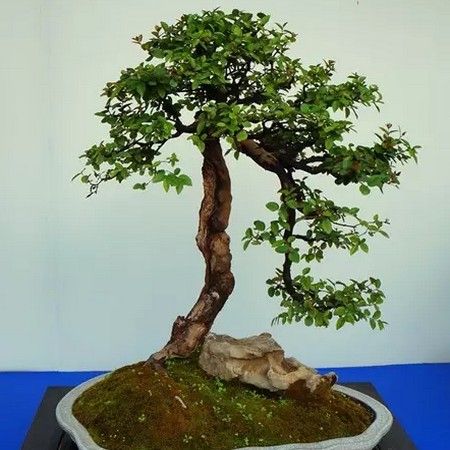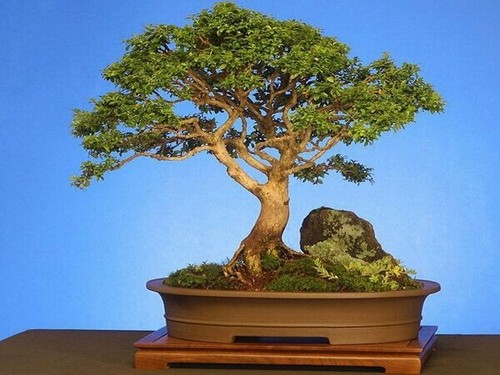Bonsai creation: dynamic and dynamic contrast, balanced and appropriate
The so-called momentum is to embody the spirit and pay attention to the problems of liveliness, momentum and balance. When creating bonsai, we must pay attention to momentum and balance, so as to give full play to the internal strength of the scene. Of course, this paspalum power is the infusion of the author's thoughts, feelings, ideals and wishes. If you ignore the momentum, the potential stir-fry full of dead things, there is no charm to speak of. People sit and walk, the mountains are skewed, the mountains are trees and rocks, all have their own graceful demeanor.

In the Qing Dynasty, Tang Dai wrote: "the mountains are flattened, the peaks are steep, the mountains are round and muddy, the cliffs are dangerous, the distant mountains are cascading, the stones are angular, and the trees are premeditated. There is a potential for every plant and tree, and there is a potential for all plants and trees." Therefore, movement and stillness are two opposite and unified states, which exist in all aspects of nature. If the mountain is quiet, the current is moving; the tree is quiet, the wind is moving.
As for people, birds and animals, rides, and so on, there are also movements. Although some scenes are temporarily at rest, they have a paspalum momentum, or the association that can cause the viewer to move.
For example, if you make a blown stump bonsai, if you tilt the trunk and claw downwind, only one broken arm and residual branch will go in the opposite direction, fighting against the long wind, which will give people an indestructible infection. This is where the momentum is applied appropriately. The following methods are commonly used to arrange the momentum:
1. Place the subject above the natural center of gravity and avoid being in the center of geometry.
2. The tree is in the shape of a skew, pitching and hanging.
3. Make it look like a fist song and dance.
4. embellished with birds and animals, boat and bridge pavilions to seek movement in stillness.
5, personifying this metaphor, the activation of dead things, such as Elephant Trunk Hill and Camel Mountain in nature.
In general, the layout of momentum should be based on the principle of "one sheet, one restraint". Zhang's power extends outward, like radiation, making people feel like people, moving and painting outside; converging power is inward, and the shape and layer are compact, making people feel deep, quiet and the painting in the painting. Therefore, the momentum layout can not be separated from the convergence and dispersion after all. There are very few works such as convergence. In addition, when setting the momentum, we should also pay attention to balance. Just ask for its momentum, so that it is delicate and artificial, but it gives people a feeling of unnatural and unstable. It is necessary to be able to "go all the way to danger and return to normal". When considering momentum and equilibrium, various factors such as height, mass and mass should be taken into account. If only one of the factors is considered, the composition must be rigid and deficient. Such as two one-foot-tall trees or two one-foot-high stones, although balanced, the composition is rigid. If an one-foot-tall tree is matched by three fists, it will be just right.
The layout of bonsai is the most taboo of stability, but we must pay attention to its momentum to achieve dynamic and static contrast, so that the works to avoid dull, vivid and momentum, while in line with the laws of nature. Dynamic and static contrast is shown in many aspects in bonsai. In the bonsai of mountains and rocks, there are positive and positive, dangerous and stable, smooth and adverse, as well as other different scenery, and so on. Sometimes through the proposition of bonsai, play the finishing touch, enhance the dynamic role of the work.
In tree stump bonsai, oblique dry type and cliff type are usually the most dynamic. Qu Gan style often gives people the association of resistance, which is another kind of momentum. Sometimes, although the scenery is balanced from left to right, there is no inclination, but there is a difference in the weight of deficiency and reality up and down, which is also a way to take advantage of paspalum. If the straight styling is handled properly, it can show the potential of a towering old tree.
Time: 2019-05-23 Click:
- Prev

Bonsai creation: insipid and strange, combining strength with softness
Insipid and peculiar are two different artistic styles and artistic expressions. In bonsai art, some works win by surprise, such as Qifeng, Qishi, strange trees, strange flowers and so on, which are relatively easy to see, while some works seem ordinary, but in fact, they are unusual, which can make the viewer feel like an olive.
- Next

Bonsai-- the "miniature 3D" version of landscape painting
Placed at home, the most health-preserving effect is not flowers or green plants, but bonsai. Because the most important role of health care is to please the eyes and feelings, statistics show that among all kinds of professions in China, the average life expectancy of calligraphers and painters is the longest, which is more than 90 years old, and most of these painters and calligraphers paint landscape paintings.
Related
- Fuxing push coffee new agricultural production and marketing class: lack of small-scale processing plants
- Jujube rice field leisure farm deep ploughing Yilan for five years to create a space for organic food and play
- Nongyu Farm-A trial of organic papaya for brave women with advanced technology
- Four points for attention in the prevention and control of diseases and insect pests of edible fungi
- How to add nutrient solution to Edible Fungi
- Is there any good way to control edible fungus mites?
- Open Inoculation Technology of Edible Fungi
- Is there any clever way to use fertilizer for edible fungus in winter?
- What agents are used to kill the pathogens of edible fungi in the mushroom shed?
- Rapid drying of Edible Fungi

